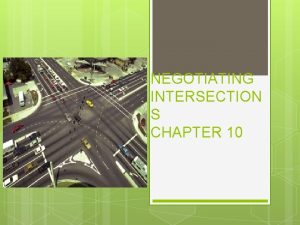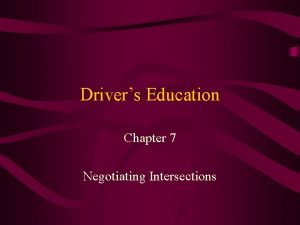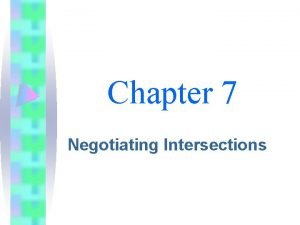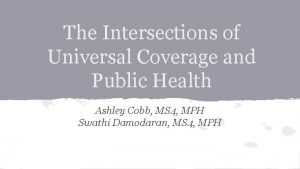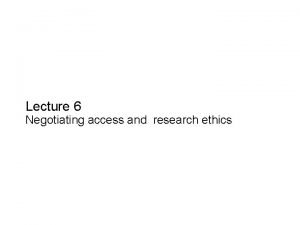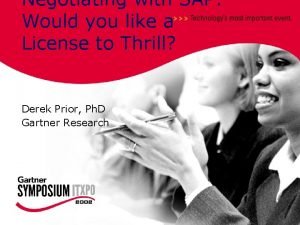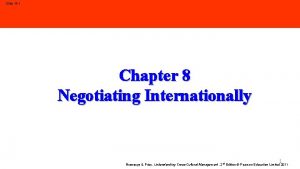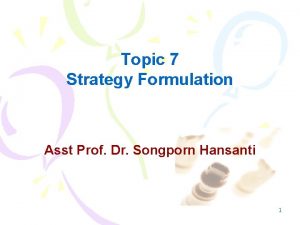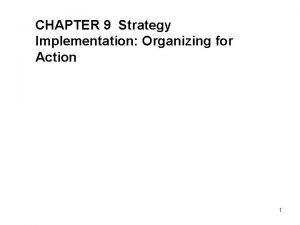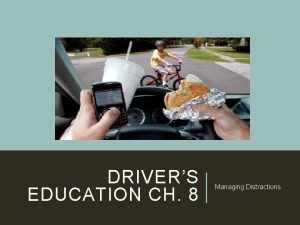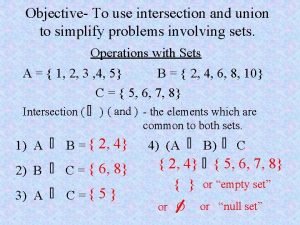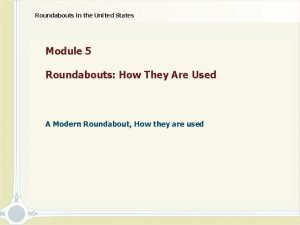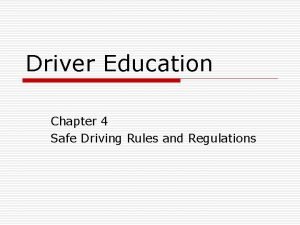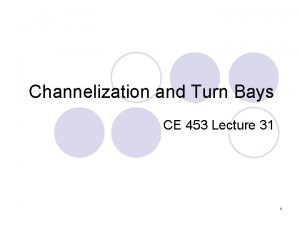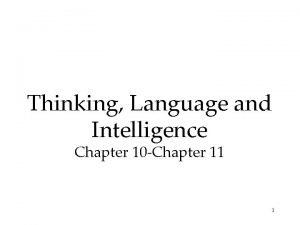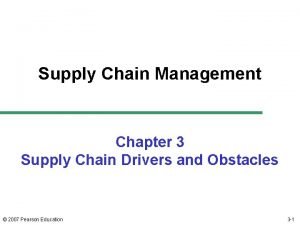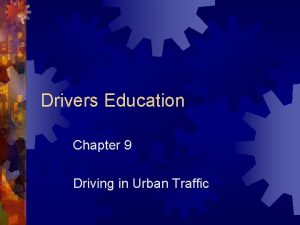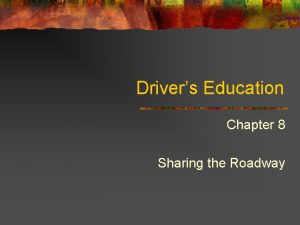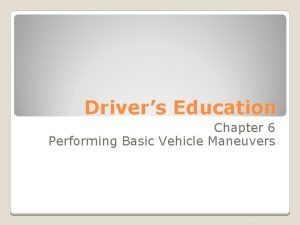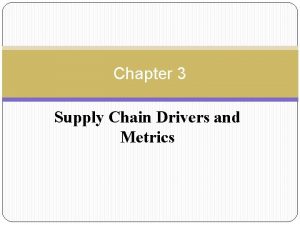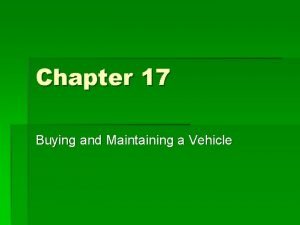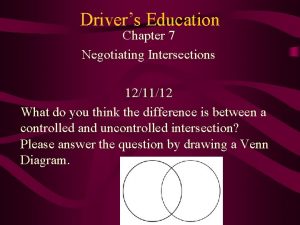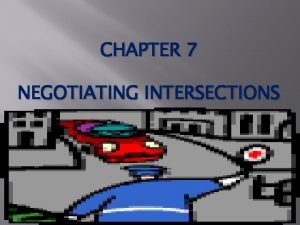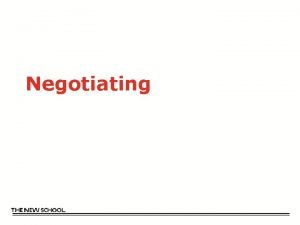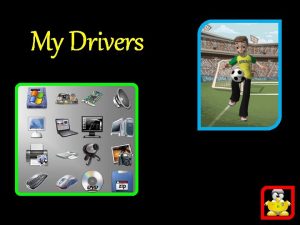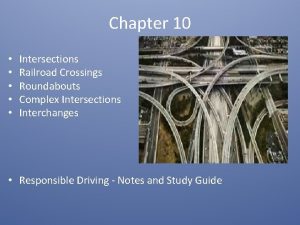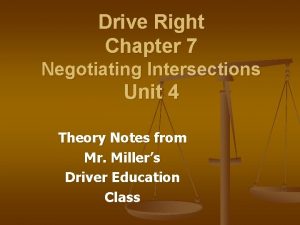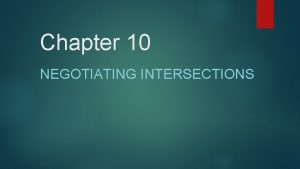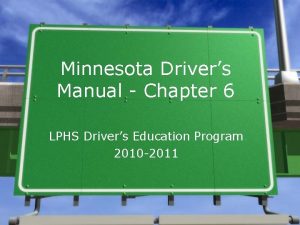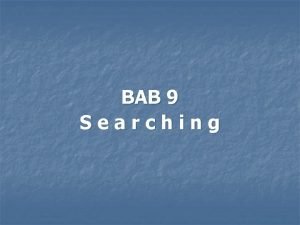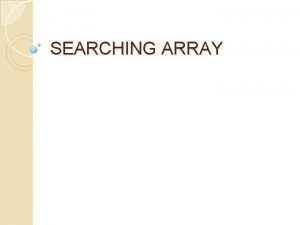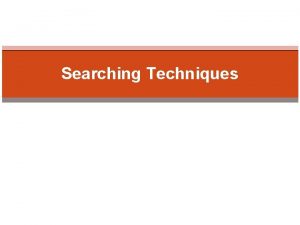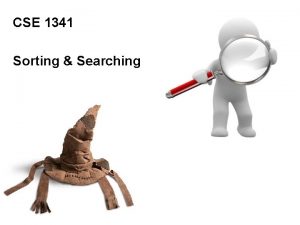Drivers Education Chapter 7 Negotiating Intersections Searching Intersections























- Slides: 23

Driver’s Education Chapter 7 Negotiating Intersections

Searching Intersections • The chances of a collision are greater at intersections than any other point on a roadway. • Look for these cue to identify an intersection ahead. • Street sign/Street light • Crossing traffic • Turning traffic • Traffic stopping

Searching Intersections • Intersections can be found in various designs. • Most are simply to roads crossing in a + or X pattern. • Other may form a Y

Searching Intersections • Traffic Circle – formed when several roadways meet at a circle. • A driver needs to know how to identify and safely negotiate traffic circles.

Approaching an Intersection • You will need to search left front, and right front zones to be certain that they are open. • You also need to look for line of sight restrictions. • Once you are within 4 -6 seconds of the intersection, your searching should widen to the left and right. • If not clear you will need to prepare to stop or change your path of travel.

Moving Through an Intersection Without Stopping • If a traffic light is green, or if the intersection has no signals or signs, and traffic is clear. • Many times it takes numerous checks because of a line of sight restriction.

Point-of-no-Return • Point-of-no-return – is the point beyond which you can no longer stop safely without entering the intersection. • Normally about 2 seconds • When in a intersection you are not allowed to make lane changes.

Deciding to Stop • You may have to stop at an intersection when you identify or predict a closed zone or line of sight restriction. • Closed zone may be a yellow or red light, or something moving into your intended path of travel.

Controlled Intersection • Controlled intersection – is one at which traffic signals or signs determine the right of way. • 2 types of signs control intersections stop and yield. • At stop sign you must come to a full stop. • At a yield sign, slow and yield the right of way.

Right Turns The proper way to make a right turn includes: • Start and end in the right hand lane • Signal well in advance • Look ahead, then left and right • Then look to the left again • Check your right side blind spot • Make the turn

Left Turns The proper way to make a left turn includes: • Signal well in advance • Move into the left-hand lane, when clear • Look ahead, left, right and left again • Check your blind spot • Make the turn when the way is clear • If making the turn from a stop, keep your wheels pointed straight until ready to make the turn • When the turn is complete, move back into the right lane when it is safe to do so

Controlled Intersection with Signals • Traffic signals normally have 3 lights to each cycle – red, yellow, and green. • Signals can also have additional lights like a yellow or green arrow.

Signals • Stale Green Light – is a light that has been green for a long time. Predict that it will turn to yellow soon. • Fresh Green Light – is a light that has just turned green. This does not guarantee that you will have a safe path of travel. Make sure that no driver on the cross street is running a red light. • Yellow Light – you must decide to stop or proceed. If before point of not return you must stop. • Red Light – When light is red you must stop.

Left Turns • Unprotected Left Turn – is made at a signal controlled intersection that does not have a special left turn light. • Protected Left Turn – when a special left turn light, green arrow, or delayed green lets you make a left while oncoming traffic is stopped.

Turns on Red • Right on Red – before turning right on a red light, come to a full stop as you would at a stop sign. • Right turns on red are permitted in all states. • Watch for signs that prohibit turning on red.

Left Turn on Red • Most states also permit a left turn on red if it is from a one-way street to another one-way street. • Follow same procedures as on right on red.

Controlled Railroad Crossing • A controlled railroad crossing usually has red lights along with a crossing gate. • Remain stopped until the lights stop flashing and the gates have raised. Railroad Safety

Uncontrolled Intersections • Uncontrolled Intersection – has no signs or signals to regulate traffic. • You must yield to the driver on the right. • Never assume the other driver will yield. • Treat uncontrolled intersections like you would a yield sign and always be prepare to stop. • Always let pedestrians go first no matter where they are crossing. • Even is a pedestrian is breaking a traffic law. • You will most likely find uncontrolled intersections in residential neighborhoods.

Uncontrolled Railroad Crossings • Does not has flashing red light or crossing gate. • In cities and towns a round yellow sign is posted 250 feet from the actual crossing. • Crossbuck – large white X shaped sign is located at the crossing. • Many times a white X is painted on the roadway. • Treat uncontrolled crossing like yield sign.

Crossing Railroad Tracks • Slow down, check tracks to both sides, listen for train. • Reduce speed to handle possible rough road crossing. • If train is approaching, stop at safe distance from the tracks. • Wait for train to clear and it is safe to cross. • Drive onto the tracks only after you have enough space and speed to clear the track even if you stall. • Never stop on railroad tracks while waiting for traffic signal. • When following buses or trucks hauling flammable content, be prepared to stop. Laws require these vehicles to stop before railroad crossings.

What is Right of Way? • Right of Way – describes the privilege of having immediate use of a certain part of a roadway. • Yield – letting others go first. Yielding is an act of courtesy. • Called “yielding the right of way. ”

Situations When You Must Yield • At stop signs to – pedestrians in crosswalk and all traffic on the through street. • At fresh green lights to – pedestrians still in crosswalk and vehicles still in the intersection. • Coming from alley/driveway to – pedestrians on sideways and all vehicles on the street. (Make 2 stops) • At yield signs to – all pedestrians and vehicles on cross street. • Yield to emergency vehicles – sounding a siren or using flashing lights. When to yield

Situations When You Must Yield • Making a left turn at a intersection to – all pedestrians in you path and all oncoming vehicles. • At 4 way stops to – all pedestrians, vehicles that arrive first, and the vehicle to the right if you arrive at the same time. • At an uncontrolled intersection to – pedestrians, any vehicle that has entered the intersection, and a vehicle to the right if you arrive at the same time.
 Chapter 10 negotiating intersections
Chapter 10 negotiating intersections Uncontrolled railroad crossings usually have
Uncontrolled railroad crossings usually have Uncontrolled railroad crossings usually have ______.
Uncontrolled railroad crossings usually have ______. Controlled railroad crossings usually have
Controlled railroad crossings usually have Chapter 7 negotiating intersections
Chapter 7 negotiating intersections Negotiating access and research ethics
Negotiating access and research ethics Negotiating with sap
Negotiating with sap Weiss’ strategic framework for negotiating
Weiss’ strategic framework for negotiating Pooled negotiating power
Pooled negotiating power Pooled negotiating power
Pooled negotiating power Pavement markings drivers ed
Pavement markings drivers ed Projectile drivers ed
Projectile drivers ed Module 5 topic 3 drivers ed
Module 5 topic 3 drivers ed How to simplify a union
How to simplify a union Module 5 intersections and roundabouts
Module 5 intersections and roundabouts Chapter 4 safe driving rules and regulations
Chapter 4 safe driving rules and regulations Turn bays
Turn bays Overgeneralization psychology example
Overgeneralization psychology example Drivers for lean supply chain
Drivers for lean supply chain Chapter 9 driving in urban traffic answers
Chapter 9 driving in urban traffic answers Chapter 8 drivers ed answers signs
Chapter 8 drivers ed answers signs Parking diagonally to a curb.
Parking diagonally to a curb. Framework for structuring drivers
Framework for structuring drivers Chapter 17 buying and maintaining a vehicle
Chapter 17 buying and maintaining a vehicle
